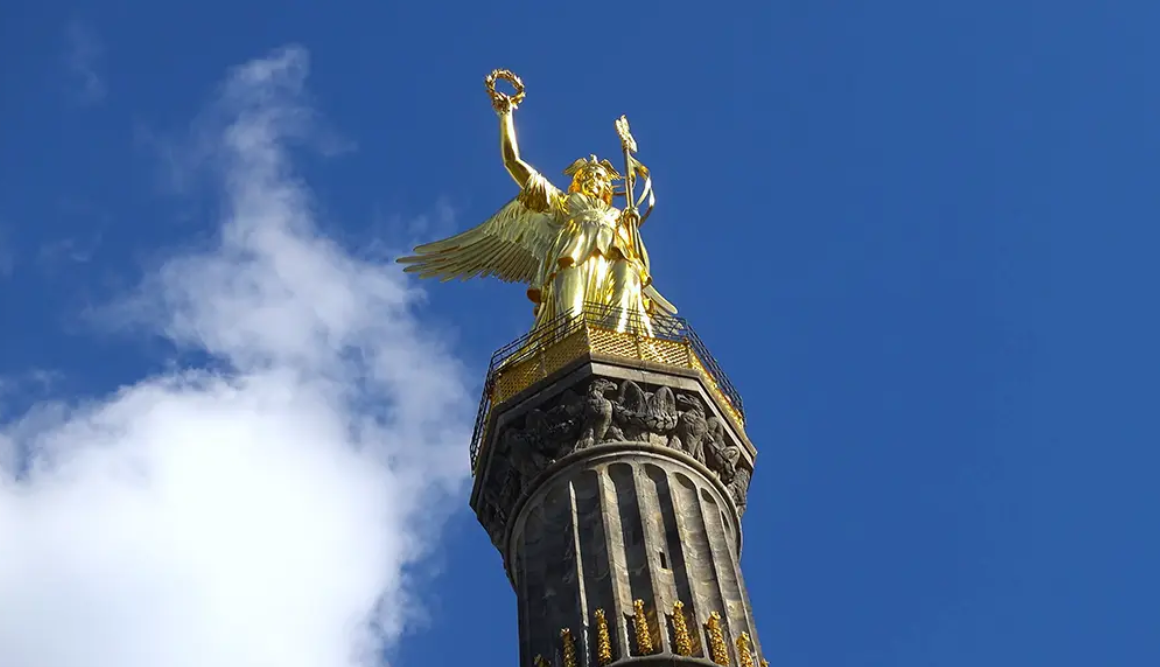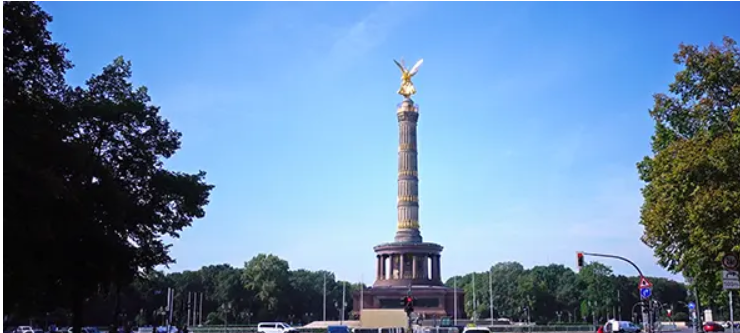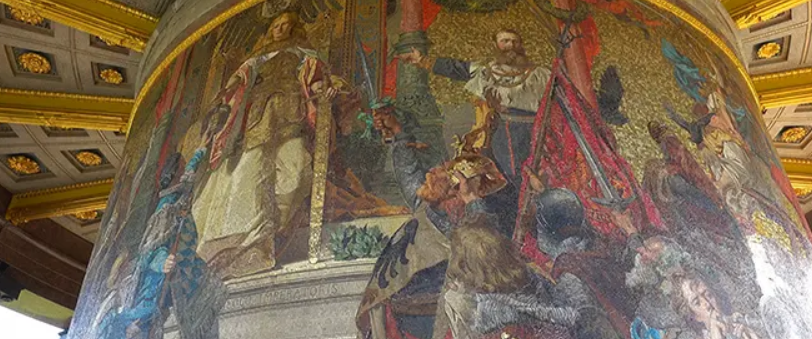One of Germany’s most important national monuments
Address: Victory Column, Grosser Stern, 10557 Berlin | Built: 1864 to 1873 | Architectural style: Neo-Renaissance | Height: 67 m
One of Germany’s most important national monuments and a major tourist attraction is the Victory Column in Berlin, located on the Grosser Stern in the middle of Berlin’s Tiergarten park. It was built by Heinrich Strack between 1864 and 1873 on Königsplatz. The Victory Column is a symbol of the Prussian war victories and was relocated to its current location along with other monuments. The column is topped by the Roman goddess of war, popularly known as the “Golden Else” (Golden Angel) in Berlin.
Directions and location of this Berlin landmark
In the middle of Berlin’s Tiergarten, framed by a sprawling park landscape, the Victory Column towers into the sky. The Roman goddess of war, Victoria, forms the final part of the column and can be seen from afar.
Anyone walking from the Brandenburg Gate along Straße des 17. Juni automatically finds themselves in the middle of the large, tree-filled park. After a walk of about 20 minutes, you reach the Grosser Stern, a gigantic roundabout. The Victory Column stands in the center.
Opening Hours and Visits
The Victory Column stands in a public square and can be visited at any time. Those wishing to climb the observation deck beneath the statue of Victoria, the goddess of victory, to enjoy a sweeping view of Berlin must adhere to specific opening hours. Generally, the viewing platform is accessible daily. Opening hours may vary depending on the weather.
Victory Column Opening Hours
April to October
Monday to Friday from 9:30 a.m. to 6:30 p.m. / Saturday and Sunday from 9:00 a.m. to 7:00 p.m.
November to March
Monday to Sunday from 9:30 a.m. to 5:30 p.m.
Note: The Victory Column is not wheelchair accessible. There is no elevator to the observation deck, and there are no restrooms.

Victory Column Admission Prices
Anyone who wants to go up to the observation deck to enjoy the view over the Tiergarten and Berlin must pay an entrance fee. Payment is only possible in cash! Admission costs:
Victory Column Admission Prices
Single Adult Ticket
€4.00
Single Concessionary Ticket
€3.00
FAQ – Frequently Asked Questions about the Victory Column
What is the significance of the Victory Column in Berlin?
The Victory Column in Berlin is a symbol of the military successes of Prussia and later the German Empire. It was originally erected to commemorate Prussia’s victories in the German-Danish War, but later other victories, such as those in the Franco-Prussian War, were added. Today, the Victory Column is an important landmark in Berlin and represents unity, strength, and national identity.
What is the name of the figure on the Victory Column in Berlin?
The figure on the Victory Column in Berlin is colloquially known as “Goldelse” or “Goldelse.” It is a bronze sculpture of a female figure depicted as Nike, the goddess of victory, wearing a crown of laurel leaves. The statue was created by Friedrich Drake and crowns the Victory Column as a symbol of triumph and victory.
How tall is the Victory Column?
The Victory Column in Berlin is about 67 meters high, including the statue of Nike. The column itself is about 50 meters high and consists of four stacked columns.
Victory Column – Special Features and Interesting Facts
One of the most famous landmarks in Berlin is the Victory Column. It towers over the Tiergarten, the largest park in the German capital. It has always been a military monument, commemorating the victories of the Prussians. Its location at the time was Königsplatz.
The Victory Column was relocated to the Great Star during the Nazi era. This was enlarged to a diameter of 200 meters by Albert Speer, Hitler’s personal architect. At the same time, another drum was added to the Victory Column. The significance and several fragments of the historical background of the Victory Column have since faded into the background. A special feature of the Victory Column is the Roman goddess of victory, Victoria, the 8.3-meter-high bronze statue on top of the Victory Column, which weighs 38 tons. She is equipped with a laurel wreath, a helmet decorated with feathers and the standard with the Iron Cross and is the counterpart to the Greek Nike, who stands for divine power, victory and the servant of sacrifice.

Victoria, created by Friedrich Drake, is now known as the Berlin Angel of Peace.
The eagle helmet also represents Victoria as Borussia, the personification of Prussia. Victoria, created by Friedrich Drake, is now known as the Berlin Angel of Peace. To reach the observation platform at the foot of Victoria, you have to climb a spiral staircase with 285 steps. This requires a bit of courage and stamina to climb the narrowing staircase.
Once you reach the observation platform, you’ll find yourself at a height of 51 meters, and a wonderful view of the expansive Tiergarten and Berlin awaits. Visitors to the observation platform on the Victory Column have Berlin practically at their feet.
Fun Facts: Berliners are known to give monumental buildings and monuments special nicknames. Today’s House of Cultures, formerly the Congress Hall, is nicknamed the “Pregnant Oyster,” and the Palace of the Republic, which stood in East Berlin, was known as “Erich’s Lamp Shop.” The nickname given to the gilded goddess of victory is “Golden Else.”
Historical Facts and History of the Victory Column
The Victory Column is a memorial to the Prussian victories in the wars against Denmark, Austria, and France (also known as the Wars of Unification) between 1864 and 1871. It originally consisted of three fragments, representing each of the three victories. Mosaics and bronze reliefs depict the history up to the founding of the German Empire.
During the Nazi era, the column gained even more attention because of its unique representation of an imperialist worldview. Gilded gun barrels can be found on the column drums, and war events are reflected in the reliefs and mosaics. The Nazis used the goddess of victory, Victoria, to propagate narratives about the supposed German superpower.

To give the Victory Column an even more impressive appearance, a fourth drum was added during its relocation from Königsplatz to the Grosser Stern, forming the column’s body. From this point on, the Victory Column had a height of 68 meters.
After the end of World War II, the demolition of the Victory Column was considered several times. The Soviet occupying forces under Magistrate Arthur Werner wanted the column removed. Subsequently, the French submitted a request for its demolition. Ultimately, the British and French voted against demolition. The Soviets, however, abstained from the vote. Therefore, the Victory Column on the Grosser Stern remained as a monument in Berlin.
Today, hardly anyone thinks about its military significance when driving around the Victory Column via the Grosser Stern. Rather, the focus is on legendary events such as the Love Parade, which took place in the Tiergarten in 1996 and attracted more than 1.5 million people. The final rally took place at the Victory Column on the Grosser Stern. This was followed by another Love Parade in 2022, called “Rave the Planet,” which attracted around 300,000 visitors to the Tiergarten. Other demonstrations and major events, such as Christopher Street Day, also take place in the Tiergarten and around the Victory Column.
Sights and attractions in the immediate vicinity of the Victory Column
The Tiergarten, with its 210 hectares, is larger than London’s Hyde Park and a green lung in the heart of the city. The large lawns and numerous trees are a wonderful place to relax and enjoy the beautiful weather after a day of shopping or visiting the numerous sights. The former hunting ground of Elector Frederick III has been repeatedly redesigned over the years. A stroll through the gigantic park reveals monuments, an English Garden, and a lake located to the south of the Tiergarten. There is a cozy café with a beer garden. To the north of the Tiergarten is Bellevue Palace, the seat of the current Federal President.
The German Resistance Memorial Center is very close to the Victory Column. The memorials to Rosa Luxemburg and Karl Liebknecht are also not far away.
On Sundays, the carillon chimes in the House of Cultures can be heard in the Tiergarten. The tower is 42 meters high, has 68 bells, and is the fourth-largest carillon in the world.
Another attraction is the Gas Lantern Open-Air Museum, located directly next to the Tiergarten S-Bahn station. There, you’ll find a publicly accessible collection of gas lanterns from Berlin and other cities, dating from different eras and even glowing at dusk.
Cafés and Restaurants Near the Victory Column
Cafes and restaurants have sprung up near the Victory Column, in the Tiergarten, and in the surrounding area. From coffee delicacies to regional and international cuisine, including exclusive delicacies, you’ll find everything you need to indulge yourself.
At the Café am Neuen See, located south of the Tiergarten on Lichtenstein Allee, guests can expect a cozy atmosphere. You can sit in the beer garden overlooking the lake almost any time of year. If it’s too cold outside, you can retreat to the warm fireplace. In addition to international dishes, the kitchen offers Bavarian snacks, beer, and coffee specialties.
Address: Café am Neuen See, Lichtenstein Allee 2
The Teahouse in the English Garden is located on Altonaer Straße. Tea lovers are in the right place, as they can choose their favorite from a wide variety of teas. Modern European cuisine is served to guests in a tasteful dining room with chandeliers. During the summer months, guests can enjoy the pleasant weather on the terrace and in the beer garden with a delicious tea, coffee specialties, or cold drinks.
Address: Teahouse in the English Garden, Altonaer Straße 2
Schleusenkrug
Located on Müller-Breslau-Straße, near the Karl Liebknecht Memorial, is the Schleusenkrug, with a lovely beer garden. The kitchen serves schnitzel, bratwurst, authentic Berlin currywurst, and other local specialties. If you want to enjoy Berlin cuisine in a relaxed atmosphere, Schleusenkrug is the place to be.
Address: Schleusenkrug, Müller-Breslau-Straße 14b
Café Minouche is located on Budapesterstraße near Berlin’s Zoological Garden. Guests can enjoy coffee specialties, cakes, and small dishes from the kitchen. When the weather’s nice, you can also sit outside and watch the people passing by as they head towards the Berlin Zoo.
Address: Café Minouche, Budapesterstraße 6
La Sardegna
Lovers of Italian cuisine will surely get their money’s worth at La Sardegna. Located on Budapesterstraße, this Italian restaurant offers pizza, pasta, special salad creations, and typical Italian fish and meat dishes in a cozy, nostalgic atmosphere or on the outdoor terrace.
Address: La Sardegna, Budapesterstraße 11
The Capt’n Schillow Restaurant Ship is a moored ship and offers a unique view of the city. A lot of wood creates a cozy atmosphere. The kitchen serves German classics, with a focus on fish, of course. Good wines and delicious beer are also served.
Address: Capt’n Schillow Restaurant Ship, Straße des 17. Juni 113
Hugo’s Restaurant
If you want to enjoy an exceptional view in a chic restaurant and be pampered with special dishes, you’ll find exactly that combination at Hugo’s Restaurant on the 14th floor of the InterContinental Berlin, with a unique panoramic view of Budapesterstraße. The kitchen serves creative dishes by Eberhard Lang, accompanied by delicious wines.
Address: Hugo’s Restaurant, Budapesterstraße 2 (in the InterContinental Hotel Berlin)